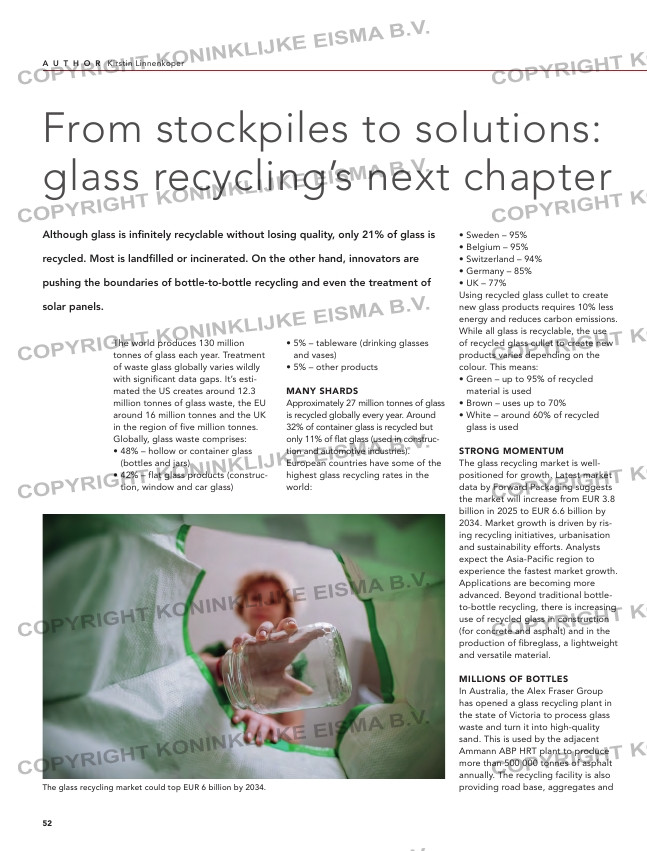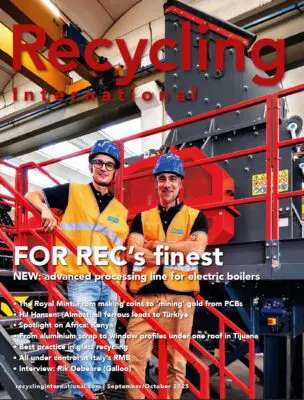Page 60 from: Recycling International September/October 2025

52
From stockpiles to solutions:
glass recycling’s next chapter
Although glass is infinitely recyclable without losing quality, only 21% of glass is
recycled. Most is landfilled or incinerated. On the other hand, innovators are
pushing the boundaries of bottle-to-bottle recycling and even the treatment of
solar panels.
sand for more sustainable road and
rail projects.
The plant can recycle up to four mil-
lion bottles and produce up to 800
tonnes of high-specification sand per
day. Materials are sourced from
‘problematic glass waste’ streams
that were previously stockpiled or
landfilled, says company managing
director Peter Murphy.
‘Our new glass recycling plant is
capable of producing 200 000 tonnes
of recycled glass sand per year. This is
equivalent to a billion bottles, effec-
tively putting an end to glass waste
stockpiles and landfill in Victoria.’
GLASS #5
Belgian industrial minerals leader
Sibelco has expanded its presence in
North America by acquiring Strategic
Materials, the continent’s largest
glass recycler. The acquisition was
completed in June and enhances
Sibelco’s capacity to process over five
million tonnes of cullet annually
across 60 global production sites,
reinforcing its commitment to sustain-
able glass recycling practices.
The container glass specialist uses
advanced optical sorting technologies
to sort the feedstock into four
colours. As well as its headquarters in
Antwerp, which processes 300 000
tonnes of glass annually, Sibelco has
operations in Canada, Mexico, the
UK, Estonia, France, Italy and Poland.
Ruud Dorscheidt, director of product
and waste management at Sibelco,
highlights a unique partnership with
prestigious fashion label Chanel. The
latter was struggling to increase the
proportion of post-consumer glass in
a special Chanel #5 perfume bottle to
celebrate its 100th anniversary. This
was because the high iron content in
glass scrap adversely affects the
transparency and shine of the packag-
ing.
Sibelco and Chanel’s long-term glass-
maker Pochet Du Courval got to
work. They ran tests at Sibelco’s
Reims plant in France and experi-
mented with various configurations of
optical sorters. After months of trial
and error, the team found a way to
produce low-iron cullet with the right
The world produces 130 million
tonnes of glass each year. Treatment
of waste glass globally varies wildly
with significant data gaps. It’s esti-
mated the US creates around 12.3
million tonnes of glass waste, the EU
around 16 million tonnes and the UK
in the region of five million tonnes.
Globally, glass waste comprises:
• 48% – hollow or container glass
(bottles and jars)
• 42% – flat glass products (construc-
tion, window and car glass)
• 5% – tableware (drinking glasses
and vases)
• 5% – other products
MANY SHARDS
Approximately 27 million tonnes of glass
is recycled globally every year. Around
32% of container glass is recycled but
only 11% of flat glass (used in construc-
tion and automotive industries).
European countries have some of the
highest glass recycling rates in the
world:
• Sweden – 95%
• Belgium – 95%
• Switzerland – 94%
• Germany – 85%
• UK – 77%
Using recycled glass cullet to create
new glass products requires 10% less
energy and reduces carbon emissions.
While all glass is recyclable, the use
of recycled glass cullet to create new
products varies depending on the
colour. This means:
• Green – up to 95% of recycled
material is used
• Brown – uses up to 70%
• White – around 60% of recycled
glass is used
STRONG MOMENTUM
The glass recycling market is well-
positioned for growth. Latest market
data by Forward Packaging suggests
the market will increase from EUR 3.8
billion in 2025 to EUR 6.6 billion by
2034. Market growth is driven by ris-
ing recycling initiatives, urbanisation
and sustainability efforts. Analysts
expect the Asia-Pacific region to
experience the fastest market growth.
Applications are becoming more
advanced. Beyond traditional bottle-
to-bottle recycling, there is increasing
use of recycled glass in construction
(for concrete and asphalt) and in the
production of fibreglass, a lightweight
and versatile material.
MILLIONS OF BOTTLES
In Australia, the Alex Fraser Group
has opened a glass recycling plant in
the state of Victoria to process glass
waste and turn it into high-quality
sand. This is used by the adjacent
Ammann ABP HRT plant to produce
more than 500 000 tonnes of asphalt
annually. The recycling facility is also
providing road base, aggregates and
A U T H O R Kirstin Linnenkoper
The glass recycling market could top EUR 6 billion by 2034.
52-53-54-55-56_bestinglassrecycling.indd 52 09-09-2025 12:14



